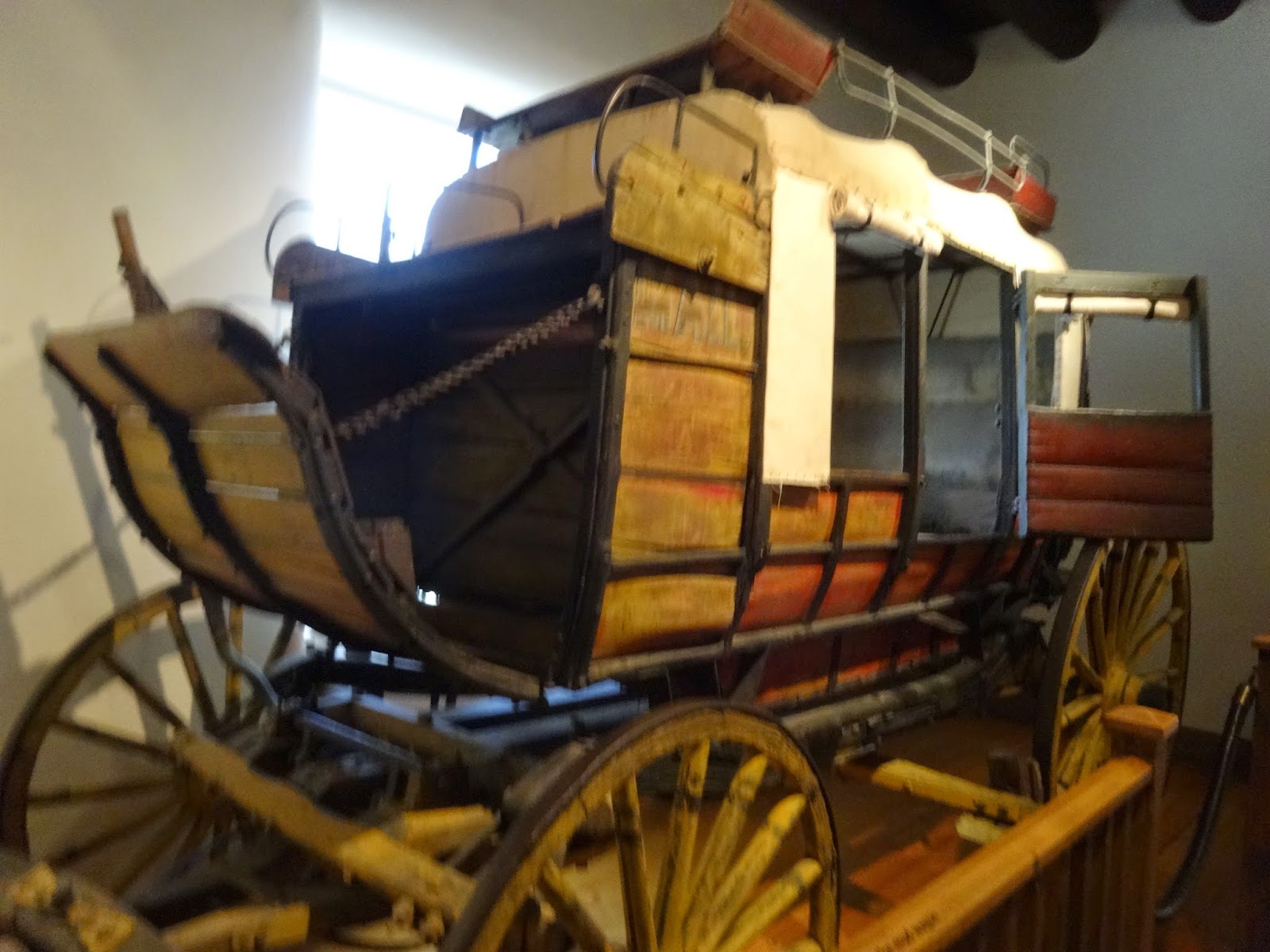Tuesday March 24: The weather continued to get colder but it was still sunny. We packed up our warm jackets and headed out to Los Alamos by way of the Shidoni Foundry—8 acres of sculpture displays and, yes, foundries, including a glass foundry.
 |
| A few of the Shidoni sculptures |
 |
| I've never seen a blue cactus bloom, but this seems to work. |
 |
| The only practical use for lobster bouys in the desert. These are made of glass. |
Then onto Los Alamos with a stop to check out the views enroute. Yep, there's snow on the mountains but the weather is beautiful for us.
We visited the Bradbury Science Museum in Los Alamos. First stop, the restroom where Pat learned how to efficiently dry her hands.
There are lots of exhibits about the research being done there today.
There were also stories about their early works--the Manhattan Project. It was extremely interesting to read about how this mesa with it's simple ranch school was transformed. In fact it disappeared. Everyone who went there had the same address (109 East Place) in Santa Fe. Personal letters were edited to assure no secrets slipped out. Frankly we spent very little time on the actual story of the successful deployment of their technology. We know that story.
Then we continued on to Bandalier National Monument, which preserves the homes and territory of the Ancestral Pueblo People. Pueblo structures there date from 1150 to 1600 CE. We'd been there about 20 years ago but it was great to see it again.
 |
| A Kiva (round pit house entered by ladder from a hole in the roof. |
 |
| A natural formation but could be a cool sculpture. |
 |
| Exiting one of the cliff dwellings. |
Dinner was at Chez Mamou...a little touch of France. A great bottle of wine from the Languedoc, an excellent cordon bleu, and interesting conversation with the wine loving couple at the next table.
Wed March 25: Museum Hill, yes there is a collection of museums on a hill outside of Santa Fe. It includes a nice cafe for a break between visiting the 3 museums. We visited the Museum of Indian Arts and Culture and the Museum of International Folk Arts.
 |
A portion of the sculpture a life-size sculpture
at the entrance to the museum complex. |
 |
No pictures in the Indian Museum
but this was in the plaza. |
The Museum of International Folk Arts...simply jam packed with displays...none with titles. There is a detailed printed museum guide that provides the explanations.
 |
Guatamalan Masks (for a minute there we were transported back
to Bill & Heidi's Mask Museumin San Miguel!) |
The exhibits are mostly displays of village life. At least a hundred of them.
We enjoyed dinner at La Boca Taberna, a basque tapas (pinxtos) bar. We discovered two things here:...a birthday beer, Tapas and two dessert wines, a Torrentes (outstanding) and a Malbec.
 |
A birthday beer with a candle mounted on the beer can.
...a bit tricky to drink! |
 |
Susana Balbo Late Harvest Torrontes and
Late Harvest Malbec. Both very nice. |
 |
| A Koshari |
Thurs March 26: We started the day by returning to capture the name and location of the shop we enjoyed so much and where a very knowledgable salesperson had enlightened us about Koshari, the clowns and enforcers at events.
 |
| 130 Lincoln Ave / Suite F |
Then on the History Museum, a half day affair. The museum covers the history under the Spanish (starting with early contact in the 1650s), then the Mexicans (following the Mexican Revolution in 1821) and then the US (following the Mexican American War in 1848). It includes the development of the Sante Fe Trail and the influx of traders and settlers. And finally the railroad led to the rise of the founder of the hospitality industry Fred Harvey.
Map showing Indian Groups across the now US
With the completion of the railroad to Santa Fe, Fred Harvey pioneered hospitality featuring consistent standards.
 |
| Fred harvey hired young unmarried women and provided them a handbook. |
During the Great Depression, the west was seen as a romantic place and holiday cards by the renowned artist "Gus" Baumann were prized.
Then there is the story of how the Native Americans contributed to the WW II (as well as coverage of the Manhattan Project...but we had learned of that in detail at Los Alamos.)
There was a special exhibit of "Marias in the Americas". I had always wondered how Mary appeared in so many parts of the world. Now of course I understand it was Mary (Maria) in various costumes surrounded by locally revered characters and symbols that would help the locals revere Mary (and the Catholic Church).
We continued on to the New Mexico Museum of Art. Since we had missed the Georgia O'Keefe museum, we were pleased to see this:
 |
| Georgia O'Keefe Red Hills with Pedernal, 1936 |
Other works that caught our eye...
 |
| Van Gogh? No. Robert A. Daughters, Truchas Road, 1961 |
 |
| Billy Schenk, Coming Down from the Mountain, 1993 |
|
While at the Art Museum, we learned that the Georgia O'Keefe had opened earlier than expected and we got to examine her various styles and subject matter.
 |
| This is a photo of a photo of Georgia's Studio with it's view of the countryside. |
A final stop to see the Loretto Chapel with it's miraculous spiral staircase with 2 full 360 degree turns and no visible means of support...
Tomorrow...on to Albuquerque.




































No comments:
Post a Comment